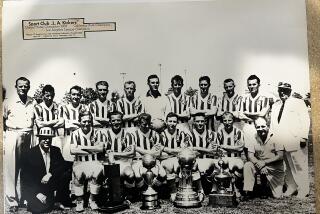A Cultural Snub for Women’s World Cup
There was something missing at the Rose Bowl when the United States won the Women’s World Cup:
Latinos.
Latinos, the dynamite behind the Los Angeles soccer explosion, were strangely absent Saturday, making up no more than 10% of the crowd--a far cry from the overwhelmingly Latino crowds that usually support Rose Bowl and Coliseum soccer, according to the world soccer federation.
The game that rocked America also got scant coverage from the usually soccer-obsessed Spanish-language radio and television stations, whose attentions were focused on the men’s Copa America tournament in Paraguay.
Latin America’s leading soccer countries, save for third-place Brazil, failed to come up with competitive women’s teams. Half the players on the Mexican team were Americans of Mexican descent, because Mexico was unable to produce enough seasoned female players. And the U.S. soccer team did not have a single Latina player, World Cup spokesman Steve Vanderpool said.
Officials say the vacuum reflects a gender divide that Latino sports officials are pushing to change, in Latin America and in Latino immigrant communities in this country, where soccer is considered a male domain. It also shows how far the United States has come since 1972, when a federal mandate ordered sports programs to include females--to correct some of the same gender inequities that divide Latin America today.
“It’s machismo,” said Manolo Cevallos, a prominent Los Angeles sports radio commentator and promoter. “They do not want women to step out of their feminine role--the home, children, housework--because it challenges the masculine role. The countries that performed the best [in the World Cup] are countries where women have a greater role in public life and society--and so of course, in soccer.”
“Our Latino communities do not embrace women’s soccer,” said Hugo Salcedo, a top official of the Federacion Internacional de Futbol Assn., or FIFA, the world soccer governing body. He is pushing for change on both sides of the border.
“In our Latin culture, girls are not supposed to play soccer,” he said. “Soccer is supposed to be a man’s sport. Women’s soccer is a new phenomenon for Latinos.”
Salcedo’s family and friends bought $87,000 in tickets for the 1994 men’s World Cup, but only $12,000 for the women’s. “They said women still don’t know how to play the game,” Salcedo said.
Salcedo and others hope the Rose Bowl victory will change this. In 1996, the U.S. women’s gold medal Olympic victory in soccer was all but ignored by television--prompting howls of protest. But deepening the Latina talent pool will require more than press attention, Salcedo said: Women need to be included in the soccer leagues that hone the talents of 7.5 million U.S. female soccer players, some of whom begin playing at age 5.
To do that, he said, means overcoming the widespread prejudice that it is unwomanly to play sports. In recent trips to South and Central America, some people told Salcedo that only lesbians play soccer.
Other factors may have hurt Latino support in Los Angeles, according to some fans.
Latinos buy as many as half their soccer tickets within days of a game. So when Inocencio Gutierrez, 24, tried to buy tickets just three days before the Rose Bowl final, the game was long sold out. He also complained of a lack of Spanish-language radio and TV coverage.
Though La Opinion provided extensive Spanish-language print coverage, ABC and ESPN broadcast the only live TV coverage of Saturday’s double-header--in English only. Spanish-language radio did not contract to broadcast the game.
“Spanish-speaking outlets will not switch from a big male event like Copa America to a women’s event--not at this point,” said Rigoberto Cervantez, a La Opinion soccer reporter who covered the women’s games. “Maybe the success of this event will open some eyes.”
In Latino immigrant communities in Los Angeles, coaches still must personally persuade parents to allow their daughters to play in the Latino leagues, which are less than 10% female, and create special new leagues for girls to play.
Parents fear their daughters will get hurt or be exposed to crime on city fields. And many Latina teenagers fear their athleticism will make them less attractive to boys, amateur sports officials say.
“Socially, in the Latino world, you’re dealing with this macho complex. It sounds stereotypical, but it’s true,” said Patrick Escobar, vice president of programs at the Amateur Athletic Foundation, which helps fund sports for more than 6,000 South Los Angeles youngsters. “In Latin America, you can kick a soccer ball around with your sister, that’s OK, she’s just not going to become a team member.”
Seven years ago, there were almost no Latinas playing soccer on inner-city teams, Escobar said. Latinas, he added, were supposed to “wear the nice dress to the game and carry the team symbol in her purse.”
Today, one of the programs he funds, Soccer for Kids, has 3,000 Latinas playing on girls teams, compared with 6,000 boys, according to Executive Director Keith Cruickshank. “We’ve seen some huge, huge increases,” Cruickshank said. “It’s really exciting and it’s only going to be magnified by the World Cup victory,” he said.
Claudia Farfan, 21, is among those whose dreams grew. Farfan was one of the first to crack the soccer gender barrier at Bell High School’s soccer program for girls in 1992.
Her father, a Salvadoran immigrant, told her soccer was “a sport for men,” but said she could play so long as it didn’t hurt her grades. Farfan’s boyfriend and friends cheered her at all her games. She is in college now, and plans to be a family court lawyer, but she still dreams of trying out for the U.S. women’s team.
“I felt so proud” at Saturday’s game, she said. “Just a few years ago no one would have dreamed of this.”
Her longtime coach, Enriqueta Hirschberg, was even more moved, because for her, the victory was like a dream long postponed. When she was 16, an amateur women’s soccer world tournament came to Mexico, inspiring her and her friends in Jalisco to start a team.
“We had to hide it all from my father,” she said. “My mother used to throw my soccer shoes out the window [for me] and tell my father we were going to Mass. The boyfriends of my team players got angry and said, ‘It’s either the sport or me.’ ”
She was infuriated when she heard a Los Angeles Spanish-language radio commentator say the Women’s World Cup players should “go back to the kitchen.”
The ambivalence concerning women’s soccer so crippled Mexico that its team--which its coach, Cal State L.A.’s Leonardo Cuellar, said was viewed as a “curiosity”--was forced to import talent.
“In Mexico, it does not have high status in society if a woman goes out and plays sports,” said Regina Oceguera, 21, of Cal Poly San Luis Obispo, one of the 10 Mexican Americans on the 20-strong team.
Linnea Quinones of San Diego State, Mexico’s starting goalkeeper, was always one of a handful of Latina players on her overwhelmingly white Southern California youth soccer teams.
“This will definitely change,” she said. “There are a lot of Mexicans living in the United States and this will help them realize women should be playing.”
Mexico washed out early in the tournament, but Quinones still felt the thrill of the U.S. victory: “Since I have that American side I was rooting for the U.S. all the way.”
For her Mexican teammates, “it’s been a lot harder. Their parents did not want them to play as much as ours did--or their society either.”
Sandra Fuentes, the registrar of the San Gabriel League, a women’s league that is coed in the summer, said female immigrants from Mexico are often thrilled to discover they can join a soccer team.
“They couldn’t play there, so when they got here, they went crazy,” she said.
Fuentes was encouraged to play as a little girl by her mother, who told her girls did not play soccer in Chihuahua, so “take advantage of it” here.
Amateur sports organizer Escobar predicts a sea change in Latin American attitudes toward women’s soccer in the wake of the World Cup.
“You’re going to see national pride take over,” he said. “Mexico and Brazil are not going to want to be relegated to fifth or sixth place.”






